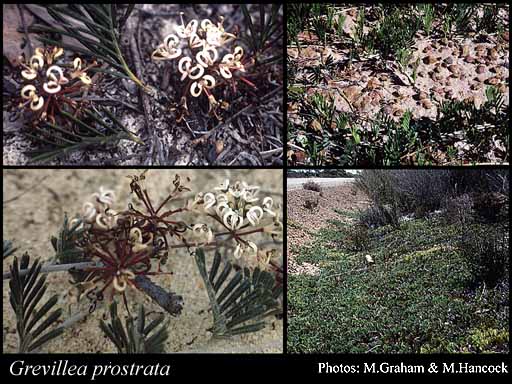- Reference
- J.Roy.Soc.Western Australia 46:129 (1963)
- Conservation Code
- Priority Four
- Naturalised Status
- Native to Western Australia
- Name Status
- Current
Loose, prostrate shrub, 0.04-0.1 m high, 0.8-1.2 m wide. Fl. cream-white/pink-red, Aug to Dec or Jan. White, grey or yellow sand, gravel. Sandplains.

Scientific Description
Shrubs, 1 m high; branchlets hairy, not glaucous. Leaves alternate, 25-70 mm long, hairy, on the adaxial or abaxial surface, the hairs straight; lamina flat, once divided, pinnately divided, divided to the midrib; lobes 10-40 mm long, 0.5-2 mm wide, the margins revolute, enclosing the lower surface of the leaf blade, forming a groove either side of the midvein. Inflorescences terminal, pink; pedicels 3-5 mm long. Perianth 4-6 mm long; tepals all free after flower opens, glabrous; ovary glabrous, stipitate, the stipe 0.5-1 mm long; pistil 6-8 mm long, white or pink, pollen presenter oblique, style glabrous. Follicles glandular hairy, not viscid, dehiscent, 13-16 mm long. Flowers in September, October or November. Occurs in the Eremaean (ER) or South-west (SW) Botanical Province(s), in the Coolgardie (COO), Mallee (MAL) or Esperance Plains (ESP) IBRA subregion(s). : Conservation code Priority Four (P4).
Distribution
- IBRA Regions
- Coolgardie, Esperance Plains, Mallee, Swan Coastal Plain.
- IBRA Subregions
- Eastern Mallee, Fitzgerald, Perth, Southern Cross, Western Mallee.
- Local Government Areas (LGAs)
- Dundas, Esperance, Jerramungup, Kent, Kondinin, Lake Grace, Perth, Ravensthorpe, Yilgarn.